Defence
Havoc double-fist press
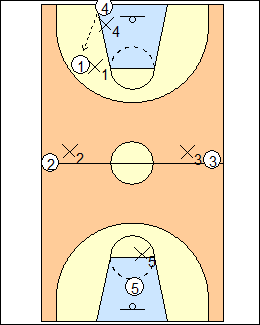
| 1 Shaka Smart
Double-fist is their man-to-man press. It's his favourite press, used about 2/3 of the time. There are three ways to trap ("fist" is fullcourt man with no traps).
See Defences - Havoc diamond press, Fullcourt man-to-man basics.
The defender on the inbound passer is the madman, all over him, going nuts. X2 and X3 get to an inside shoulder until the ball comes in, so they don't get beat deep.
Havoc is their whole style of play, it starts with fullcourt pressure but also includes halfcourt pressure, they don't want teams to run their halfcourt stuff, continue to trap from time to time, and deny passes. They also want to play fast in offensive transition, throw it ahead, shoot in the first 6-7 seconds, and fly at the offensive glass, where you can really do some damage.
Why they press:
- turn you over, first and foremost (steals are best)
- force you to take a quick or bad shot
- create offensive opportunities (sometimes defence is the best thing to create good offence)
- force tempo
- the press is difficult to prepare for
- make players do things they're not comfortable doing
- fatigue is a huge part of what they do (fatigue makes a coward of us all)
- make depth a factor, he wants to play 9-10-11 players, get them in the game in the first 8-10 minutes, you can't play the way they play for more than 3-4-5 minutes, they go from playing big to playing small
- it's exciting and fun
- identity, it's their brand.
You have to emphasize
- energy - five guys flying around, all the time
- be careful not to foul too much (Pitino - fouling negates hustle)
- communication - talking makes you quicker, players have to know what press they're in and get matched up
- deflections are huge (measure them, players keep track of their own in practice, one or more per minute in a game is great)
- players need to understand that the goal on defence is a team stop, not just stopping their guy. |
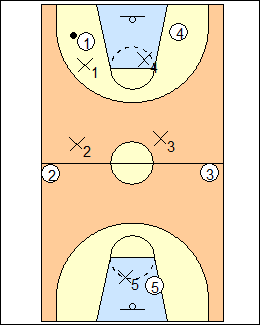
| 2 X1 pressures the ball, X2 and X2 are 1/3 the distance from their man to the ball, towards the mid-line, pointing pistols, shrink the court but the ball cannot go over their head. X2 and X3 can extend their 1/3 if 1 is under a lot of pressure.
X4 is 1/3 as well, stunting as the ball comes towards him (stunting is quick foot and hand fake), and adjusting his 1/3 as 4 and the ball move. They can live with a backward pass but don't want the ball going over X4's head, 4 is off to the races.
X2 and X3 are also stunting.
The deepest guy is not 1/3, he is as deep as the deepest, i.e. as deep as he needs to be so the ball doesn't go over his head for a layup (he might be right next to 5, or a step ahead).
|

| 3 a) Trap the turn
X1 and X4 are going to trap, X1 takes 1 to the sideline and turns him back (puts a foot on the sideline), X4 has to go trap once he sees the back of 1's head. No fouls in a trap (foul with your lower body), take a charge if he tries to split.
The other three defenders have to think like trappers, don't hold your guy's hand, read eyes and shoulders.
Most players need to be taught what is a great trapping situation, a) pressure on the ball, close enough to touch him, b) element of surprise - trap the turn, he can't see you, c) location - the corner is great, or just over halfcourt up a sideline (the middle is not as good). Any two out of three is good, if it's not a good trap, don't go.
VCU always traps the guards, almost never traps 5 (it's a "one-man trap", 1 on 1), and may or may not trap 4. If you trap 5, he can pass to a better ballhandler who is off to the races.
|
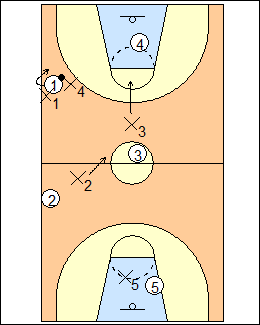
| 4 There are two interceptors, X2 is interceptor sideline, X3 is interceptor high, X2 takes away a pass to 2 and 3, X3 takes away a pass to 3 and 4, in most cases shading towards 3, the more dangerous pass.
One of the most important teaching points is that the job of the trappers is to force an obvious pass, e.g., make 1 pivot away so the obvious pass is to 4 (shown), if he pivots back, the obvious pass is to 2. The interceptors then take away the obvious pass, moving as 1 pivots (work on this in practice).
|
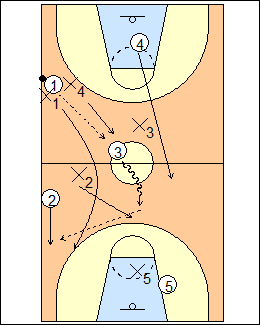
| 5 On a pass to 3 in the middle, X4, X1 and X3 are in a state of emergency, they are above the level of the ball, they need to run down 3 with back pressure, trying to back-tip, which is a big game-changer (they try to get 4-5 per game).
Fix-it situation - 3 is a good player who's not going to let you back-tip, the defence has to stop the ball, get below ball level and get matched up, find a man (it might not be your man) by talking, pointing, getting in a stance, and jumping to the ball. They want one defender on the ball, not zero and not two.
Outnumbered situations are huge, they play some form of 2 on 1 every day, e.g. from halfcourt or the elbows, don't allow a layup. Also do 1 on 2 to halfcourt, defenders pass to an attacker and close out to trap, arms up, chop the feet, be elastic (he's got his dribble, move as he moves).
See Pressing - Porter 1 on 2, Defences - 1-2-1-1 Tennessee, 2-2-1 Vance Walberg.
|

| 6 b) Forcing the action
In double-fist, a lot of teams will just clear out, VCU forces the action, the defender of the last guy to leave comes back and forces the action right around the top of the key extended.
When X1 hears "clear-out", he knows X4 is coming back, he's got to get the ball out of the middle third of the floor, the trap is going to happen from the middle of the floor.
See Defences - Maryland fullcourt, Kentucky fullcourt, Florida match-up.
|
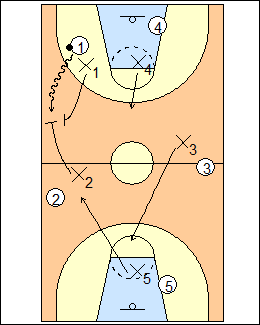
| 7 c) Trap up the sideline
Most teams are smart enough to stretch 2 as 1 dribbles up the sideline, if a team doesn't have good spacing, trap up the sideline if X2 can stunt and get there in 1-2-3 strides. X5 is the interceptor sideline, X4 is the interceptor high, X3 becomes the goaltender (some teams have him come over as interceptor sideline).
VCU doesn't do this as much as because shooters are too good and the guy who ends up having to rotate (X5) is their slowest guy (also, never run at anybody when they are looking at you).
Sometimes they deny the inbounds pass (double-fist face), e.g., if behind late in a game, they may keep a guy on the inbound passer and go for a deflection, or take him off and put him in centerfield. They want guys running through a sloppy inbounds pass. Be on your guy's inside shoulder, forearm in his gut, deny with the other hand, if he breaks deep you're with him, if he breaks to the ball at the very least arrive on the catch, don't gamble and not get it, he's got a straight line going the other way.
VCU also has a press that is used specifically when the other team has a dominant ballhandler, they want to take him out, make someone else get the ball and bring it up.
See Defences - White and black match-up, Florida match-up, Billy Tubbs fullcourt zone, Wootten fullcourt.
|
|
|